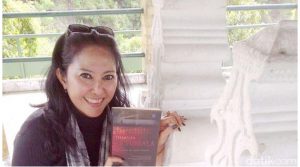Endang Moerdopo: Her journey as a Dancer and Storyteller

When Endang Moerdopo arrived in Aceh back in 2004, the fierce tsunami had just devastated the province, popularly called Tanah Rencong. Endang had come to Aceh to assist the Reconstruction and Rehabilitation Agency (BRR) to help disaster victims get over their trauma through her expertise in dance therapy, as well as collect data for her master’s thesis in sociology.
During her stay in Aceh, Endang, who now teaches social welfare sciences and is a postgraduate school director at the Widuri School of Social and Political Science in Jakarta, became acquainted with the story of a powerful, outstanding woman named Malahayati.
Curiosity led Endang to do further research about this phenomenal woman and write about the national hero in her novel.
“I had heard the name Malahayati mentioned in history books, but that’s all,” Endang said in our conversation.
“Although her name is mentioned and used in many places in Aceh, when I tried to find more information about her, nobody could give any explanation, nor was there sufficient reading material about her,” she said.
That reality brought her to realize that in Aceh and some other places in Indonesia, history had only been passed from generation to generation orally. Soon, Endang’s head was filled with questions, such as the background and personal information of Malahayati and what made her so extraordinary.
Keumalahayati, or Malahayati as she was later known, was the first female admiral of the 16th century in the Aceh Sultanate Royal Navy and probably also the first female admiral in the modern world (excluding Artemisia I). Malahayati’s track record is documented in a number of museums in Holland, Portugal and Malaysia.
Admiral Malahayati was killed in combat while attacking the Portuguese fleet in Teuluk Krueng Raya in 1604. She was buried in Lereng Bukit Kota Dalam, a small fishing village 34 kilometers from Banda Aceh.
Endang started searching for Malahayati’s grave in 2005. The BRR Aceh staff took several days to find it, with the help of several local villagers.
“When they finally found the grave, it was in a poor state and the villagers had been using it as a place to hang their laundry,” recalls Endang. “The funny thing was after that, I often felt drawn to visit Malahayati’s grave in my spare time, while in Aceh.”
Born in Yogyakarta on April 5, 1968, Endang holds bachelor, master and doctorate degrees in social welfare from the University of Indonesia. In the end, she managed to complete her project with the BRR in Aceh, a master’s thesis and a novel on Malahayati.
“For the research of this historical novel, I would have liked to go to Spain and Holland too, but due to limited funds, I only went as far as Malaysia,” she said.
In her 350-page novel, Endang writes about how Malahayati gathered all the widows of the soldiers who died in battle in Teluk Haru and trained them to fight. Her army was named Inong Balee, or the widow fleet. The army started with 1,000 women and later increased to 2,000 troops. In 2017, Malahayati was named a national hero by President Joko “Jokowi” Widodo.
The first edition of her novel was titled Perempuan Keumala: Sebuah Epos Untuk Nanggroe (The Keumala Woman: An Epic for Nanggroe) in 2008. The book was a hit and became a reference for many. A revised edition has recently been published by Grasindo with a new title, Laksamana Malahayati, Sang Perempuan Keumala: Sebuah Epos Untuk Nanggroe (Admiral Malahayati, the Keumala Woman: An Epic for Nanggroe). Endang hopes that the book will soon be translated into English.
“This book marks a note in history and is proof that I was once there in Aceh,” she added with a big smile.
Traditional Indonesian dancing has been in her heart since she was little. As a professional Balinese dancer, Endang was often invited to perform in front of state visitors at the Presidential Palace in Jakarta during the reign of Soeharto. She has also mastered Javanese, Sundanese, Betawi as well as other regional dances. Currently, Endang still dances for art development purposes and does art missions in other countries, and is often asked to judge several dancing contests and festivals.
“Dance therapy is a creative intervention method for handling social problems,” she said.
“Performing dance movements can help someone cope with their problems in a non-verbal way.”
Endang is an active listener who does not take any story for granted, especially when it is about violence against women.
“One day, while I was having my nails done at Kuta Beach, the Balinese woman who was painting my nails began talking about her husband. She told me how he would ask her to have sex with him the whole day. Her story disturbed me. This urged me to do research on that matter,” she said.
Later, for her doctorate dissertation, Endang took Balinese dancing as a therapy method for helping sexual domestic violenc victims deal with their trauma.
“I chose this topic because there are lots of women who cannot talk about this problem as it’s something taboo and is a very private area to talk about.”
Courtesy : Thejakartapost
Photo : detikNews
[social_warfare buttons=”Facebook,Pinterest,LinkedIn,Twitter,Total”]



